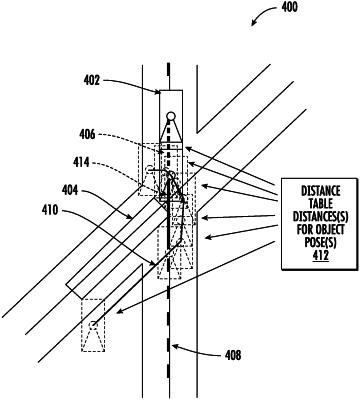| CPC B60W 60/00274 (2020.02) [B60W 50/0098 (2013.01); B60W 2050/006 (2013.01); B60W 2552/45 (2020.02); B60W 2554/20 (2020.02); B60W 2554/402 (2020.02); B60W 2554/4026 (2020.02); B60W 2554/4029 (2020.02); B60W 2554/4041 (2020.02); B60W 2554/801 (2020.02); B60W 2554/802 (2020.02); B60W 2554/803 (2020.02); B60W 2554/804 (2020.02)] | 18 Claims |

|
1. A computer-implemented method of maneuvering an autonomous vehicle (AV) traversing a roadway, comprising:
receiving, by one or more processors of a vehicle computing system, forecast information associated with one or more predicted trajectories of an actor in the roadway;
regenerating, by the one or more processors, a distance table for a relevant trajectory of an action, using an original distance table which was previously generated for processing constraints, the relevant trajectory being based on a forecast for the one or more predicted trajectories of the actor with a trajectory of the AV;
generating, by the one or more processors, a plurality of margins for the AV to evaluate, the plurality of margins being based on a plurality of margin types for providing information about risks and effects on passenger comfort associated with a future proximity of the AV to the actor;
generating, by the one or more processors, continuous scores for each candidate trajectory from among a plurality of candidate trajectories, wherein each candidate trajectory is within a margin of the actor generated for the relevant trajectory; and
issuing, by the one or more processors, a command to control the AV based on the continuous scores, to maneuver with respect to a plurality of constraints in the roadway, wherein:
generating the continuous scores for each candidate trajectory is based on one or more of:
a penalty configured by transforming a margin value at a time interval into the penalty;
a discount factor to account for increasing uncertainty about interactions that will be performed further in future, wherein a subsequent time interval is offset from a start of a planning cycle;
an actor-type factor, discounting parameters per actor type, including at least one of a vehicle, a crosswalk-following pedestrian, other pedestrian, cyclist, or other object, to apply based on interaction classifications; or
a social acceptability factor that classifies a decision taken by a candidate trajectory with respect to the margins to a plurality of actors simultaneously.
|